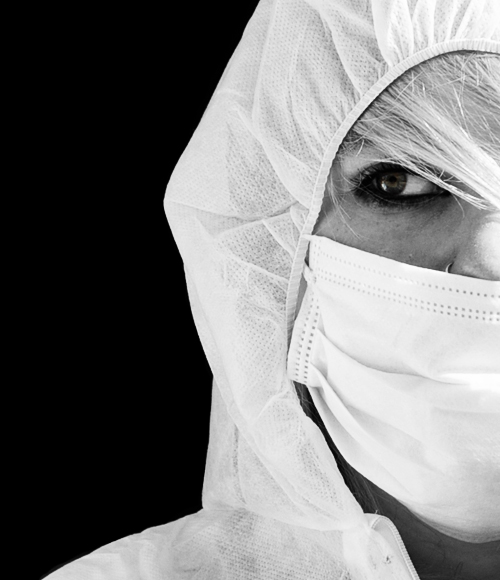Three weeks ago I came down with the flu. I was sicker than I have been in years. For a full five days, I could only manage to quiver on the couch and binge watch old seasons of Scandal. One episode would end and the next would automatically begin until Netflix asked incredulously, “Are you still watching Scandal?” I was.
Finally, still feverish, I hauled myself off the couch and into the clinic. The flu has been especially terrible this year, and I was convinced I might be one of the unlucky few destined to drop dead of the illness. The doctor, however, sent me home. “You should feel better in a few days,” she said. And I did.
As I slowly recovered, I pondered how I had contracted the virus. My daughter had been ill, but not nearly as sick as I was. Still, it seemed likely that I had picked up her illness. And then I remembered something that made it seem even likelier. For more than a week I had been sucking snot out of her nose . . . with my mouth. That may sound crazy, but it has become common practice among parents thanks to the Snotsucker — a device as beloved as it is disgusting.
The Snotsucker, more commonly called the NoseFrida, is exactly what it sounds like, a device designed to suck snot. But this is not your run-of-the-mill bulb syringe, which relies on a squeezable rubber ball to create suction. The NoseFrida leverages the superior power of the human mouth. This adorable cartoon demonstrates how it works.
And the thing does work, disgustingly well. The NoseFrida currently has 4.5 stars on Amazon with 8,812 reviews. “Fastastic product!” reviewers rave. “This thing is amazing!” I took a quick poll of my mom’s group, and all of the moms who responded had used it at least once or twice. One called it a “lifesaver.”
But does NoseFrida’s efficacy come at a cost? After all, babies get congested when they are sick. Their sticky snot is filled with, according this 2010 study, “large amounts of respiratory viruses.” So is snot sucking a bad idea? Could I be huffing pathogens from my daughter’s nasal secretions into my lungs?
“Absolutely,” says Vincent Racaniello, a virologist at Columbia University in New York. “If the baby has respiratory syncytial virus or flu or any other respiratory virus, the person doing the sucking would definitely have a chance of being infected.”
To prevent this from happening, the NoseFrida contains a “hygiene filter,” a piece of blue foam about double the length of a pencil eraser. It sits between the fat tube that goes against the baby’s nose and the slim straw that goes inside the unlucky sucker’s mouth. But Racaniello says it wouldn’t provide much protection. The lacy filter contains holes so large they are visible even from a distance. In the lab, Racaniello uses filters that have holes less than half the width of a red blood cell, and they still let viruses through.
The product’s website claims that the filter is “clinically proven to prevent bacterial germs from traveling anywhere.” That claim, however, is based on a single study of 12 sick babies at Malmö University Hospital in Sweden in the late 1990s. To look at transmission of bacteria from the suckee to the sucker, the researchers retrofitted the NoseFrida with a second, sterile filter that would trap any bacteria before they entered the mouthpiece. The team then used these devices to siphon snot from congested babies with respiratory infections. They cultured the snot that accumulated in the tube as well as the mouthpiece filters. Ten of 12 snot samples contained bacteria, but none of the filters were contaminated.
This is hardly definitive proof that bacteria cannot be transmitted, however. And, more importantly, the researchers didn’t look at transmission of viruses, which cause the bulk of respiratory infections. Getting respiratory viruses in your mouth isn’t a terribly effective way to contract a respiratory illness, Racaniello says. But he points out that sucking deeply would bring aerosolized virus into the lungs, and “that is a more efficient way to get infected.”
There is no way to prove that I contracted influenza by sucking snot out of my daughter’s nose. There are other, simpler ways to transmit the virus. Sneezing works. So does coughing. And a study published earlier this year found that people infected with the flu emit virus even when they breathe. Still, I haven’t touched the NoseFrida since I recovered. Racaniello thinks that’s a good call. Before we spoke he watched a video of a woman using the device so he could get a sense of how it works. “I was just shocked,” he says. “The young lady seems to be blissfully ignorant of what could be happening.”
***

Wow! I didn’t even know about these devices. My kids stumbled through childhood with snotty noses. Great piece.
“I was just shocked,” he says. “The young lady seems to be blissfully ignorant of what could be happening.”
Yeah, me too.
I often marvel that my parents and I both made it through my childhood…no snotsuckers were in existence, seat belts only latched around our waists if used at all and not anybody that I was aware of and certainly none of the kids I grew up playing with, wore a bicycle helmet. Great piece, Cassandra. hmm…snotsucker…who knew?